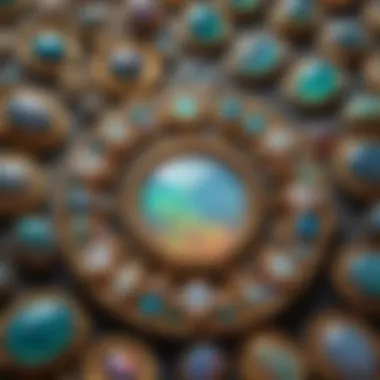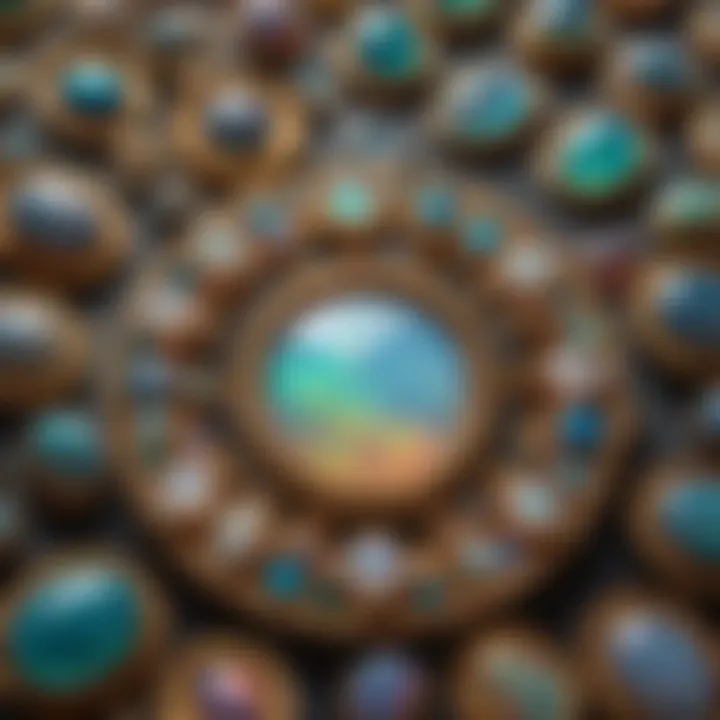In-Depth Guide to Opal Stone: Characteristics and Significance


Intro
Opal may not be the first gemstone that comes to mind when one thinks of precious stones, yet it boasts a captivating blend of beauty and mystique. As we delve deeper into the world of opal, we are invited to discover not only its exquisite aesthetic qualities but also its rich history and cultural significance. This journey unveils the multifaceted nature of opal, a stone that has inspired artists and jewelers while carrying deep meanings across various societies.
In this discourse, we will examine the characteristics that distinguish opal from other gemstones. From its striking color play to its varied forms, every aspect of opal contributes to its allure. The sections that follow will provide a comprehensive insight into the unique traits of opal, its formation processes, and the significance it holds in the wider realm of gemstones.
Prologue to Opal
Opal is far more than just a pretty stone; it carries a wealth of history, scientific intrigue, and cultural resonance. This section lays the groundwork for understanding opal by highlighting its diverse characteristics, which set it apart from other gemstones. The richness of opal's visual dynamic and the intricacies involved in its formation provide an inviting gateway into the world of geology, art, and spiritual symbolism.
Moreover, opal holds a significant place in various cultures, making it not only a gemstone of beauty but also one of profound meaning. From the legends of ancient civilizations to modern uses, the opal is indeed a captivating subject. This article aims to sketch a path through its fascinating aspects, ensuring a holistic appreciation for this unique gem.
Defining Opal
Opal is a mineraloid, known for its captivating play-of-color, a phenomenon where different colors appear as the stone is moved. Composed chiefly of silica with varying amounts of water, opal takes on an array of colors, often resulting in a visual spectacle that can mesmerize anyone who gazes upon it. Unlike crystalline minerals, opal lacks a defined crystal structure, which lends it a unique charm in the world of gemstones.
Types of Opal
The realm of opal isn't just limited to its overall definition; it also includes various types that each bring their own flair and vibrancy. Understanding these different types is crucial for gemstone enthusiasts and collectors alike.
Precious Opal
When most people think of opal, they typically imagine Precious Opal. This variety is distinguished by its remarkable play-of-color, which results from microscopic silica spheres interacting with light. It's often the star in jewelry pieces due to its vivid hues that dance and change with the light. Precious Opal can come in a myriad of colors, ranging from deep blues to fiery oranges, making it a coveted choice for many.
The appeal of Precious Opal lies not just in its visual beauty. It's commonly used in high-end jewelry, often set in rings or necklaces, adding value to both the piece and the wearer. However, care must be taken as these stones can be delicate, requiring gentle handling and protection from scratches.
Common Opal
In contrast, Common Opal lacks the stunning color-play found in its precious counterpart. Instead, it exhibits a more uniform appearance, with colors typically ranging in hues from white to beige to gray. While it may not catch the eye with vibrant flashes, Common Opal holds its own significance.
This variety serves as a more affordable option, making it accessible to a broader audience. Often used in beadwork and less intricate designs, Common Opal allows people to experience the beauty of opal without breaking the bank. However, they may not be as durable as Precious Opal, and their simpler aesthetic might not appeal to everyone.
Fire Opal
A truly unique type is Fire Opal, characterized by its transparent to translucent appearance and a warm body color that ranges from yellow to orange to red. The vivid colors of Fire Opal are especially striking, and while it may not boast the same play-of-color as Precious Opal, it compensates with its bold and bright demeanor.
This particular opal type is often associated with passion and creativity, making it a popular choice among artists and creative souls. Due to its vibrant color, Fire Opal can be an eye-catching addition to jewelry, although it too requires careful maintenance to ensure its longevity.
"Opal is not just a stone; it’s a canvas for light and a story waiting to be told."
Geological Formation of Opal
Understanding the geological formation of opal is crucial if we want to appreciate this gem's beauty and uniqueness. Opal, which is composed mainly of silica and water, forms in varying geological environments. The interplay of elements like temperature, pressure, and moisture creates the wonderful colors and patterns that define opal stones. Grasping these processes helps in recognizing not just where opals come from but also in valuing their rarity and intriguing characteristics.
The Science Behind Opal Formation
Opal's formation is a fascinating tale that begins deep within the Earth. It's essentially a mineraloid made up of microscopic silica spheres arranged in a pattern. The intriguing part is how these spheres diffract light, leading to the splendid play-of-color associated with precious opal. This process typically unfolds in the following steps:
- Silica-rich solutions seep through cracks and spaces in the Earth's crust.
- Evaporation or cooling of these solutions enables silica to crystallize and form a gel-like substance.
- Over time, as conditions change, this gel hardens to form opal.
Interestingly, this can occur in various geological settings, like volcanic rocks or sedimentary environments, where water can create the right conditions. Each locality can yield different varieties of opal, making it a true testament to nature’s artistry.
Environmental Conditions Favoring Opal Creation
Several environmental factors play a vital role in the formation of opals. Here are some critical conditions that influence their creation:
- Temperature: Moderate temperatures favor silica deposition. Extreme heat or cold can interrupt the process.
- Moisture: A balance of water is essential since too much can wash away the silica, while too little might lead to dehydration of the opal.
- Geological Activity: Areas with volcanic activity tend to produce opal deposits, as the silica solutions are often derived from the magma below.
- Time: Patience is key! Opal formation is a slow process, requiring thousands or even millions of years to produce a gem-worthy stone.
In essence, the combination of these factors ensures the right environment for opal to flourish. The subtle dance of earth processes contributes to the richness and diversity of this mesmerizing stone.
"Opals are like a little piece of the universe, bottled up in each stone, telling the story of its creation through its color and texture." - Unknown
In summary, the geological formation of opal is a testament to Earth's complexity and creativity. The unique conditions that allow these gemstones to form add an extra layer of appreciation for gem enthusiasts and collectors alike. Understanding these processes not only heightens one's knowledge but also deepens the respect for the natural world around us.
Physical Properties of Opal
Understanding the physical properties of opal is crucial for anyone who is keen on gemstones. These properties—color, transparency, opacity, hardness, and durability—not only define the aesthetic appeal of opal but also its practical qualities and overall value. In this section, we will dissect these elements to appreciate why they matter so much in the realm of gemology.
Color and Play-of-Color
Color is often the first thing that captures your eye when you gaze upon an opal. What makes opal exceptionally unique is its ability to exhibit a phenomenon known as play-of-color. This term refers to the shifting colors that appear as you move the stone around, akin to how a chameleon changes its hues.


The play-of-color comes from the arrangement of silica spheres in the opal's structure, which diffract light. Each opal is a one-of-a-kind piece of art, showcasing a spectrum that can range from vibrant reds and greens to the more subdued blue and white tones.
- Factors Influencing Color
- The base color of the opal can vary from white to black.
- Thickness of the silica layers affects saturation.
- The type of light under which you view the opal can dramatically change perception.
The value of an opal can often soar or plummet depending on its color play. Stones that display vivid reds and greens tend to fetch higher prices, while those with more muted tones might remain less popular in the market.
Transparency and Opacity
Unlike many other gemstones, opals can range dramatically in transparency. You might encounter transparent opals, which allow light to pass through and showcase a striking interplay of colors and opaque opals, which emit their beauty without revealing the inner workings.
- Transparency: Generally, more transparent opals are viewed as more desirable. They not only enhance the play-of-color effect but are also favored in fine jewelry.
- Opacity: Opaque opals, while less sought after, have their charm. They can display a stunning depth of color. They tell their own story, often appearing in tribal jewelry and artisan crafts.
Over time, all opals may experience changes in transparency, especially when exposed to extreme temperatures or dehydration. Keeping these stones in optimal conditions is vital to maintain their beauty.
Hardness and Durability
Opals are relatively delicate when compared to harder gemstones like diamonds or sapphires. They register about 5.5 to 6.5 on the Mohs hardness scale. This means they can be more susceptible to scratching and damage if not cared for appropriately.
- Durability Considerations:
- Regular cleaning is essential. Harsh chemicals can dull the opal's surface.
- Avoiding rough handling ensures longevity.
- Storing opal—always put it in a soft cloth or padded container to avoid accidental scratches or chips.
However, despite its fragility, the allure of opal lies not just within its visual beauty but also its emotional connection for many. Each stone carries a story, and caring for it becomes a ritual in itself.
The dance of color, the play between light and shadow, and the myriad emotions captured within an opal make it not merely a gemstone but a vibrant piece of earth's artistry.
Historical Significance of Opal
Understanding the historical significance of opal is crucial in appreciating both its natural beauty and its enduring place in various cultures. Opal has been more than just a decorative stone; it has played roles in mythology, art, and symbolism throughout human history. By examining how ancient civilizations valued opal and how modern interpretations have changed, one can reflect on its legacy.
Opal in Ancient Civilizations
Greeks and Romans
The Greeks and Romans saw opal as a stone of great value. For them, opal symbolized pure love and hope, embodying beauty that captivated the imagination. The gemstone was often thought to bestow prophetic powers upon those who possessed it. Ancient writings reveal that opals were linked to various artists and orators who believed these stones could bring inspiration and creativity. This link to creativity makes it a fascinating subject; it reflects how art and natural beauty can intertwine, acting as muses in themselves.
The Greeks, particularly, regarded opal as a gift from the gods, associating it with divine properties. In contrast, Romans wore opal not just for its allure but for supposed protective qualities, believing it could guard against disease and misfortune. It was also regarded as a status symbol, where owning such exquisite stones was a testament to one's wealth and social standing. The uniqueness of opal's color-play gave it an edge over other gemstones, ensuring its popularity in jewelry.
Indigenous Cultures
Indigenous cultures around the world have woven opal into their traditions and stories, ascribing significant meanings to this gem. For many, opal represents a connection to the earth and spirit, believed to embody the essence of water and air. In Aboriginal Australian culture, opals are considered the tears of the ancestors, and special stories surround their origins. These beliefs contribute to a rich tapestry of cultural identity tied to natural resources, enhancing the stone's value beyond mere aesthetics.
Local tribes often used opals in rites and ceremonies, believing the stones could carry messages from the spirit world. The uniqueness of this belief system gives opal an added layer of significance, integrating it into the social fabric of these cultures. Moreover, the colors seen in opal were often interpreted as reflections of the life force of the land, making it not only a gemstone but a story-teller of the earth’s history.
Opal in Modern Times
Artistic Representation
In modern periods, opal continues to capture the attention of artists and creatives. The stone often finds itself at the center of various artistic representations, from visual art to literature. The shifting hues and play-of-color of opal inspire many to express complex emotions and themes. Notably, several contemporary designers use opal in their works to symbolize change, fluidity, and transformation, which are key elements in modern narratives.
Creating jewelry with opal allows artisans to connect with its historical significance and infuse the piece with meaning. Many collectors find opal jewelry appealing because each piece is a testament to craftsmanship and an homage to a rich cultural heritage, enhancing its desirability.
"Art is an essential reflection of the many narratives running through society, and opal serves as a beautiful conduit for that expression."
Symbol of Hope
Today, opal also signifies hope and renewal for many individuals. This connection resonates particularly in today's cultural landscape, where people seek symbols that inspire and uplift. Opal's stunning array of colors can evoke feelings of optimism and creativity, marking it as a cherished stone for various communities.
Moreover, in contemporary practices, opals are often used in healing therapies. They are believed to aid in emotional balance, support self-expression, and even reassure wearers in times of uncertainty. This unique feature of opal, combined with its historical significance, serves as a reminder of the interpersonal connections many have with gemstones. People choose to wear or use opal as a way of nurturing their spirit, connecting to a rich history that spans centuries.
In summary, opal's historical significance is not merely a tale of aesthetics; it is a testament to its role in human culture across ages. From ancient societies that revered its power to modern narratives that celebrate its beauty and utility, opal continues to be a profound symbol linking us to various stories and meanings.
Cultural Significance of Opal
Opal's charm extends far beyond its stunning visual appeal. Across various cultures and civilizations, this gemstone has found a place of honor, rich with symbolism and narrative weight. Understanding the cultural significance of opal reveals a tapestry woven with stories, beliefs, and values that both reflect and influence the societies that cherish it. In this section, we will explore the myths and legends surrounding opal, alongside its manifestations in literature and art, providing a holistic view of its cultural relevance.
Myths and Legends Surrounding Opal
Many gemstones come with their own legends, but opal takes the cake with tales that span centuries and continents. In ancient Rome, opal was considered extremely lucky, highly sought after for its ability to bring good fortune to its wearer. The Romans believed that it contained the essence of all precious stones, a belief that stemmed from its kaleidoscopic colors.


In contrast, during the 19th century, opals bore a less favorable reputation. The novel "Anne of Geierstein" by Sir Walter Scott cast a shadow on the stone when it depicted an opal causing a tragedy. The mischaracterization fueled superstition, leading some to believe that opals were harbingers of misfortune. Today, these myths play an interesting role in opal's narrative, as they contribute to its mystique while showcasing the change in societal perceptions over time.
"Opal is a world filled with colors, a mirror into the spirit of the earth."
– Traditional Aboriginal Wisdom
For Indigenous cultures in Australia, opal holds a particularly sacred place. It is deeply intertwined with their spiritual identity and natural lore. Stories told by Indigenous peoples about the gemstone often involve creation myths, where opal signifies joy and light. In a broader sense, this reflects the connection between natural elements and cultural identity, showcasing how opal signifies a deeper sense of home and belonging.
Opal in Literature and Art
Opal’s significance transcends mere jewelry; it resonates through literature and the arts, influencing creativity across centuries. Writers have often drawn on opal's mesmerizing qualities, using it as a metaphor for dreamlike states, illusiveness, or even chemical reactions of emotions.
In literature, works ranging from those of Shakespeare to contemporary novels utilize opal as a potent image. In some texts, it appears as a symbol of transformation or a catalyst for change, encapsulating the notion of beauty that can hide deeper complexities. Its unique play-of-color represents the multifaceted nature of human emotions, making it a relatable symbol in narratives.
In the realm of visual arts, opal's striking color variations have inspired painters and sculptors alike. The Impressionists, known for their emphasis on light and color, often found a muse in opal's shimmering hues. Artists used shades found in opal to enhance their color palettes, showcasing its influences on creative expression.
Metaphysical Properties of Opal
The metaphysical properties of opal hold a unique place in the hearts and minds of those who believe in the stone's power. Linked to intuition, inspiration, and creativity, opal is often considered a potent source of emotional healing. Individuals who delve into the world of gemstones frequently find themselves drawn to opal, as it embodies a spectrum of meanings and potentials that resonate on both spiritual and emotional levels.
Emotional and Spiritual Benefits
Opal is said to have a remarkable influence on the emotional body. Many people claim this stone assists in enhancing one's self-awareness and encourages emotional expression. One of the most notable benefits is its ability to bring suppressed emotions to the surface, offering a cathartic release that can be both liberating and enlightening.
- Opal is often described as a stone of transformation; it helps individuals navigate emotional turbulence by promoting clarity of thought.
- It encourages the wearer to embrace vulnerability, fostering strong connections with others. The importance of emotional balance can’t be overstated, and opal serves as a gentle guide in this journey.
- This gemstone is thought to assist in enhancing creativity and imagination, allowing a person to explore new avenues of thought and innovation.
Opal's impact is not only limited to emotional healing; it extends into spiritual realms as well. Some users report heightened intuitive abilities when working with this stone. It is believed that opal can enhance one's connection to the spiritual world, tapping into inner wisdom that may have been dormant. Many practitioners of energy work utilize opal during meditation, claiming it helps align their energies and open channels for spiritual growth.
Practical Uses in Healing Practices
In practical terms, opal's metaphysical properties lend themselves well to various healing practices. Here are some common applications for this gemstone:
- Meditation: Holding or placing opal on the body during meditation is thought to enhance the experience. This helps individuals access deeper states of awareness and promotes relaxation.
- Crystal Healing: Many holistic healers believe that opal can be strategically placed on key chakra centers to balance energy flow. For instance, placing an opal on the heart chakra is believed to foster emotional healing and love.
- Elixirs: Some practitioners create opal-infused water by charging the stone in water overnight, believing that this elixir captures the stone's energetic properties for physical consumption. Note: Always ensure the opal is safe in water before use.
- Incorporation in Jewelry: Wearing opal in rings or pendants serves not just as adornment; it is thought to be a constant source of emotional support and enlightenment, making it a popular choice for those looking to benefit from its properties daily.
"Opal is more than just a stone; it's a portal to emotional insight, spiritual alignment, and profound personal growth."
Embracing the metaphysical properties of opal allows enthusiasts to deepen their understanding of themselves and their spiritual journeys. By recognizing both emotional and practical applications, one can maximize the stone's potential in their life.
Mining and Sourcing of Opal
Mining and sourcing of opal is not only vital for understanding the gemstone’s market but also it holds immense weight in cultural and ethical discussions. The origins of opal affect its allure and value, presenting a direct link to geological factors, mining practices, and the socio-economic implications connected to these activities. As consumers become more mindful of where their products come from, the ethical sourcing of opal garners importance. It prompts us to consider not just the beauty of the stone but also the journeys it undertakes from the ground to our jewelry boxes.
Major Opal Mining Locations
Australia
Australia reigns supreme in the realm of opal mining, accounting for nearly 95% of the world's production. The famous Lightning Ridge is not just a pretty name; it’s a hotspot for black opals, the most coveted variety due to their unique colors and patterns. The vast regions of Queensland and South Australia also contribute significantly, hosting a plethora of opal fields.
One standout feature of Australia is the diversity of opal types available. Here, one can find everything from white opal to the stunning boulder opal, which retains part of the host rock, adding a layer of character. This variety makes Australia a favorable choice for jewelers and collectors alike. However, mining practices in these areas may raise environmental concerns, prompting discussions about sustainability and responsible mining efforts.
Ethiopia
Ethiopia has emerged as a prominent player in the opal market, especially since the discovery of the Wollo opals in recent years. The country’s opals are notable for their vibrancy and display of colors, often characterized by a bright body tone and high transparency. This contributes to their growing popularity in the global market.
A unique aspect of Ethiopia's opal production is the relatively new mining practices compared to those in Australia. Being newer to the trade, Ethiopian miners often face challenges around regulation and certification, impacting the overall market dynamics. However, the potential for growth in sustainable practices and community development could pave the way for more ethical sourcing in the future.
Mexico
Mexico is home to the fire opal, which boasts its fiery spectrum of colors like orange and red, a striking contrast to the cooler hues of Australian opals. The mining regions, mainly in the state of Querétaro, are known for not just production, but also unique cultural practices around their gemstones. The close-knit communities involved in opal mining often celebrate their crafts through traditional rituals and practices.
The unique chemical composition of Mexican opal gives rise to its distinctive characteristics. While it may not have the widespread fame of Australian varieties, Mexican opal is gaining traction with collectors and designers who value its vibrant aesthetic and cultural significance. However, the question of sourcing often looms large here too, with local practices raising various ethical considerations regarding labor and environmental impacts.
Ethical Sourcing Practices
As the gem industry faces growing scrutiny regarding ethical sourcing, attention to responsible practices becomes paramount. Gemstone enthusiasts and buyers increasingly demand transparency around where and how gems, including opals, are mined.
Ethical sourcing involves several considerations:
- Fair Labor Practices: Ensuring miners receive just compensation and work in safe conditions.
- Environmental Stewardship: Emphasizing sustainable mining practices to minimize ecological footprints.
- Community Engagement: Supporting local economies by investing in community projects and education.
Thus, understanding mining locations and ethical sourcing is not just an academic endeavor; it paints a comprehensive picture of the opal stone’s journey and its implications on culture, value, and ethical considerations in the market.
"A gemstone’s journey is not merely in its beauty, but also in the story it carries from the earth, through labor, to the hands of the buyer."


In exploring the mining and sourcing of opal, we not only uncover the geological wonders but also the human narratives that breathe life into these rare gems.
Evaluating Opal
Evaluating opal is fundamental to understanding its true value and significance in the world of gemstones. It encompasses several metrics, each contributing crucial information for buyers, collectors, and enthusiasts alike. In an environment inundated with options, knowing how to properly assess opals helps in making informed decisions, whether for personal collection or as a potential investment.
Factors Affecting Opal Value
Color
When talking about opals, color isn’t just a superficial trait; it’s at the heart of what makes an opal truly desirable. The vibrant hues and variety of color play a significant role. Typically, the more vivid and diverse the colors seen within an opal, the more valuable it is. The most sought-after opals typically showcase a range of colors including rich reds, greens, and blues that dance in the light, reflecting the stone's internal structure.
One unique aspect of color is how its intensity can captivate the beholder. The beauty found in an opal's play-of-color makes it a beneficial choice for jewelry design and artistic representation. However, not all colors carry the same weight; for instance, lighter shades are generally less prized compared to those vibrant deep hues. This means that while an opal may exhibit multiple colors, if those colors are pale, it could skew the value toward the lower end.
Clarity
Clarity in opals pertains to transparency and presence of inclusions. A clear opal allows the colors and patterns within to shine without obstruction. Consequently, higher clarity generally translates to higher value. A notable characteristic of opals is their opalescence— this shimmering play of light gives them character and life.
Having a good clarity, while appreciated, is a popular choice among buyers, especially those keen on setting opals in engagement rings or other fine jewelry. One must note though, clarity can be a double-edged sword. Some inclusions create a unique story or aspect to the stone that some collectors find appealing, providing them different advantages.
Size
Size matters, particularly in the realm of gemstones. Larger opals tend to command higher prices, predominantly due to their rarity. In this regard, size is often synonymous with value. A sizable opal can be a centerpiece, adding gravitas and allure to any collection.
However, while a larger opal may be impressive, it can also possess characteristics—like lower color intensity or questionable clarity—that may diminish its overall appeal. In this case, the unique feature of size is somewhat ambiguous. An opal that is massive yet dull may not captivate as much as a smaller, vividly colored stone with excellent clarity.
Identifying Quality Opal
When it comes to identifying quality opal, knowing what to look for can save a buyer time and money. The various factors such as base color, brightness, and patterns play a critical role in categorizing opals.
To assist in entailing the complete picture:
- Brightness: How strong is the color regardless of the base hue?
- Pattern: Does the opal display a unique play-of-color? Patterns can amplify the uniqueness and desirability of each stone, a point certainly to not overlook.
- Cut: A well-cut opal enhances its play-of-color, revealing its stunning interior to the fullest.
By familiarizing with these aspects, enthusiasts are better equipped to discern quality opals, ensuring they amplify their collection or selection with stones of both aesthetic and financial value.
"Understanding the opal's intricacies can turn a mere purchase into a passion."
Each buyer brings their own set of criteria to the table, but by being aware of the various facets of evaluating opal, navigating this enchanting world becomes a far less daunting task.
Caring for Opal
Caring for opal is crucial to maintain its beauty and longevity. Unlike some other gemstones, opals can be more susceptible to damage if not handled carefully. The importance of proper care cannot be overstated, as it directly impacts not just the appearance but also the overall value of the stone. As a unique and delicate gemstone, opal demands respect and thoughtful treatment to keep it shining like the stars in the night sky.
Cleaning and Maintenance
When it comes to cleaning opals, the approach should be gentle. Harsh chemicals and abrasive materials can dull their surface or even cause cracks. A soft cloth or a sponge dampened with warm, soapy water is often sufficient. Here’s a more detailed look:
- Use mild soap: A few drops of dish soap mixed with water will do just fine. It is important to avoid any strong detergents or cleaning agents.
- Soft cloth: For drying, opt for a soft cloth. Avoid using paper towels, as these can scratch the opal's surface.
- Avoid ultrasonic cleaners: While they may be tempting for certain gemstones, opals are sensitive and can be damaged by ultrasonic waves.
- Frequency of cleaning: Regularly cleaning your opals, especially after wearing them, helps retain their lustrous shine and keeps dust or oil from accumulating.
By following these cleaning practices, you can help ensure that your opals remain beautiful for years to come.
Storage Considerations
When it comes to storing opals, a little precaution goes a long way. Here are some key considerations:
- Individual soft pouches: It’s wise to store opals separately in soft pouches or cloths to prevent scratches from coming into contact with harder stones.
- Avoid sunlight: Direct sun exposure can lead to fading and damage, so store them in a cool, dark place.
- Humidity control: Opals are hydrophane, meaning they can absorb moisture. Keeping them in a dry environment helps prevent them from swelling or cracking under different humidity levels.
- Avoid extreme temperatures: Steer clear of places where the temperature fluctuates wildly, such as next to a heater or in an uninsulated garage.
"Opal's allure lies not just in its light and color, but in how we care for it, ensuring its magic endures through time."
Closure
The final chapter of any article holds immense weight, particularly in the case of our exploration of opal. The conclusion serves not merely as a summary but as a lens through which one can appreciate the intricate tapestry woven around this captivating gemstone. Through the journey we've taken—from the formation of opal deep within the Earth to its significance in various cultures—we find ourselves at a compelling juncture.
The Enduring Allure of Opal
Opals have been capturing hearts and minds for centuries, cherished not just for their stunning aesthetics but also for their rich historical and cultural significance. Unsurprisingly, their allure remains undiminished in the modern era. Unlike any other stone, opal exhibits a unique interplay of color, a phenomenon known as play-of-color, which enchants viewers and invites contemplation.
The fascinating narratives of the ancients often entwined with opals showcase their perceived mystical properties. In today’s context, they are sought after not merely as decorative items but as symbols imbued with emotional value. Many people believe that opals harness energies promoting creativity, self-discovery, and balance.
"Opal is a gemstone that connects us to our inner selves, promoting peace and emotional stability."
For collectors and jewelry designers, opal represents a meeting point of artistry and natural beauty. The diverse range—from precious opals to the fiery hues of fire opals—presents a splendid range of choices for every taste. Collectors are not just drawn to their beauty; they often find themselves enthralled by the story each opal tells—that of its origin, the unique conditions that crafted it, and its voyage through human history.
In the realm of geology and mineralogy, opal sparks interest due to its intriguing formation processes and various types. Understanding how different environmental conditions shape these stones enhances one’s appreciation of not just the gem itself but also the Earth’s geological wonders.
As we close this article, one must reflect on the profound connection we have with opal. It stands as a reminder of nature’s artistry and the eternal relationship people have forged with the earth's treasures. Opal’s versatile narrative transcends mere aesthetics, interweaving science, mythology, and personal significance into a rich fabric that is as complex as the stone itself.



